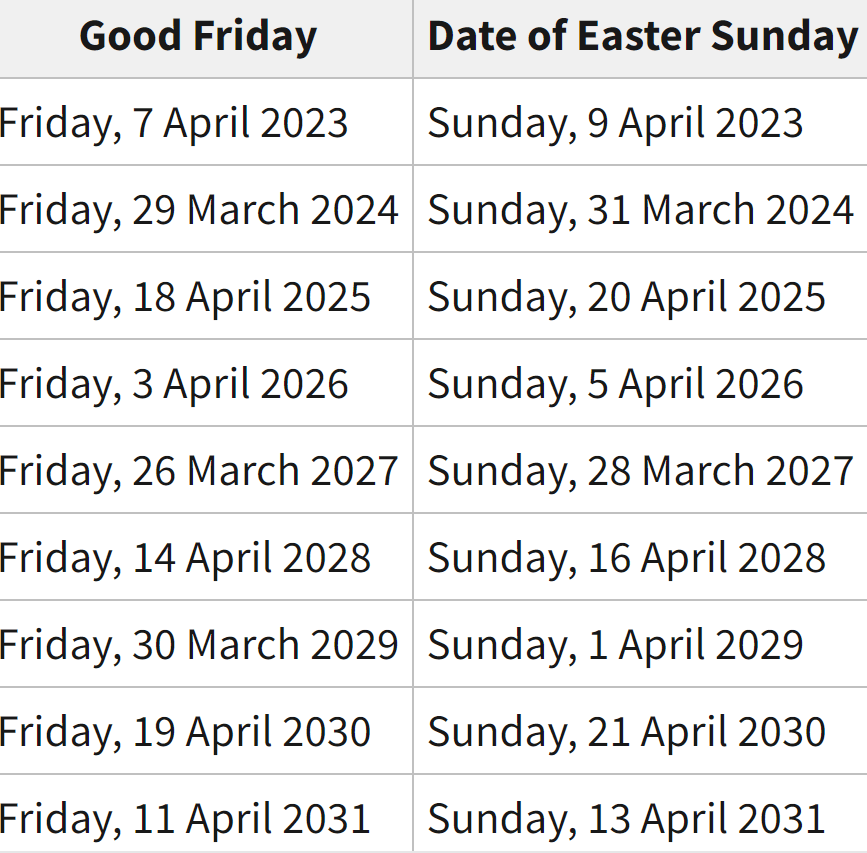The season of Easter holds profound significance within the Christian faith, symbolizing renewal, resurrection, and divine hope. As congregants prepare their hearts and minds for this sacred observance, the question inevitably arises: What are the dates for Easter this year? For 2025, enthusiasts of the faith and the curious alike will find themselves looking towards April. This guide endeavors to elucidate the festivities surrounding Easter Sunday and the broader timeframe of Holy Week, allowing believers to immerse themselves in a deeply meaningful exploration of their faith.
Traditionally, Easter Sunday is celebrated on the first Sunday following the first full moon on or after the vernal equinox. This esoteric method of determining the date reflects early Church practices as they sought to create a uniform calendar for this paramount festival. In 2025, Easter Sunday will occur on April 20th. With the dates surrounding it falling within Holy Week, believers will engage in a variety of observances leading up to the grand celebration.
The week preceding Easter, known as Holy Week, begins with Palm Sunday. In 2025, this important day will be observed on April 13th. Palm Sunday commemorates Jesus’ triumphant entry into Jerusalem, a moment steeped in prophetic significance. Congregants often decorate their worship spaces with palm fronds as a nod to the joyful shouts of “Hosanna!” from the multitudes who welcomed Christ as their king. This combination of jubilance and retrospective contemplation sets a reflective atmosphere for the contributions of the forthcoming week.
Following Palm Sunday, Christians observe Maundy Thursday on April 17th, a day that emphasizes the Last Supper, during which Jesus instituted the Eucharist, famously washing the feet of His disciples. The term ‘Maundy’ originates from the Latin word “mandatum,” meaning “command,” as Jesus commanded His followers to love one another. This ritual, rich with symbolism, invites congregants to engage with the themes of servitude and humility. Many churches partake in foot-washing ceremonies, which bring forth many emotional responses from both the faithful and those witnessing the act.
Good Friday follows, observed on April 18th, marking the crucifixion of Jesus Christ. It is a day steeped in solemnity, as worshippers reflect on sacrifice and redemption. Attending a Good Friday service often involves readings from the Passion narratives, prayers of lament, and the veneration of the Cross. This experience can pose a challenge—how does one reconcile joy and sorrow? The answer is found in the duality of the Gospel itself, where death leads to resurrection, despair transitions to hope, and loss begets new life.
The Easter Vigil is celebrated on the evening of Holy Saturday, April 19th. This service is one of the most luminous and poignant times in the Christian liturgical year. It typically commences after sunset, beginning with the lighting of the Paschal candle, symbolizing the light of Christ dispelling darkness. The proclamation of the resurrection, the immersion of the catechumens, and the joyous celebration of baptisms stands at the heart of this vigil. The symbolism encapsulated within this service illustrates the transformative power of Easter—a message of hope that echoes across generations.
Then comes Easter Sunday, an occasion pulsing with the energy of jubilant celebration. April 20th, 2025, will witness congregations returning to worship spaces adorned with lilies and vibrant decorations, confirming the essence of the resurrection: “He is risen!” Sermons on this triumphant day emphasize victory over sin and death, delivering assurances of eternal life to believers. The warmth of fellowship often extends beyond the sanctuary as families and friends gather for celebratory meals, underscoring the communal aspect of faith.
The days that follow Easter Sunday lead into the Easter season, which lasts for fifty days, concluding with Pentecost. During this period, Christians are encouraged to reflect upon the ramifications of the resurrection—what it means to live in the reality of Christ’s victory. As believers traverse this journey, the intentionality of their daily lives is inevitably questioned: How do we embody the resurrection in our interactions, decisions, and relationships?
Certainly, as 2025 approaches, many believers will ponder the profound significance of Easter. The challenge lies not only in the logistics of remembering specific dates but also in internalizing the core messages of renewal and redemption. How can one exemplify the ethos of resurrection in a world laden with despair and weariness? This question evokes a deeper exploration of Christian living, challenging individuals to embody hope amidst uncertainty. The Easter season thus invites humanity into a collective journey of restoration, urging all believers to affirm the tenets of love and grace that Jesus exemplified.
Ultimately, Easter is not merely a date on the calendar; it is a call to engage profoundly with one’s faith. As Christians approach April 20th, 2025, may they do so with an expectant heart, prepared to witness the transformative power of the resurrection both in their lives and within the community. The challenge posed is not simply about marking the dates but about embodying the renewed spirit that Easter heralds—a spirit that is capable of surmounting life’s ultimate trials.



